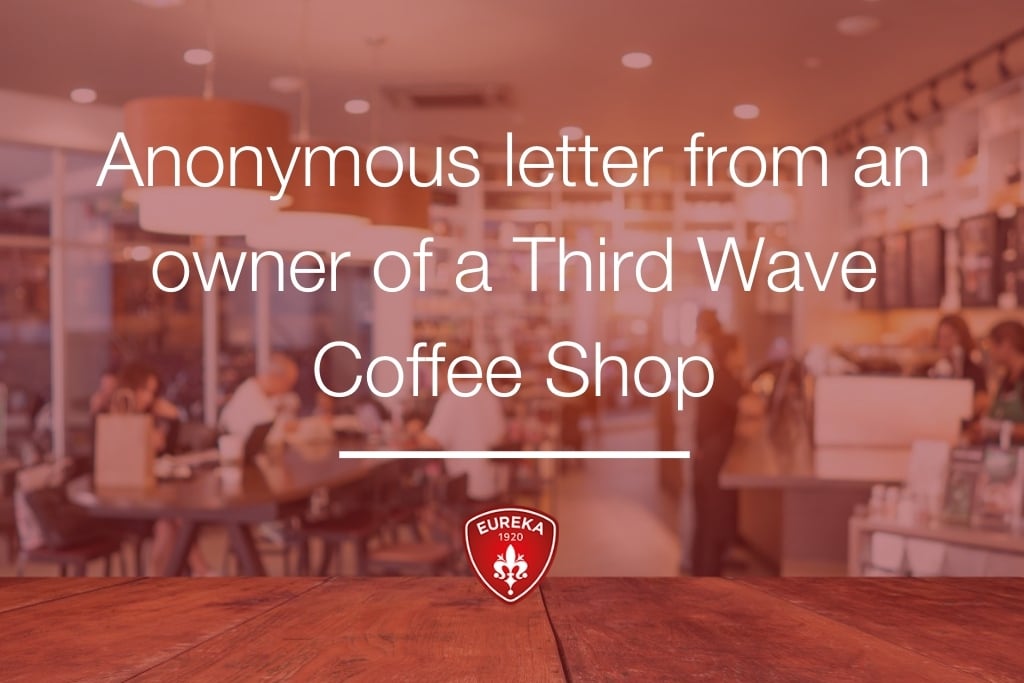Eureka Blog
Anonymous letter from an owner of a Third Wave Coffee Shop
Hi,
I am the owner of a Third Wave Coffee Shop, contemporary.
My main aim is to serve fantastic, amazing coffees and obtain a profit in return.
To do this, I took on highly specialised staff, I bought the best equipment on the market, I fitted out a space that could hold a large crowd of people and, most importantly of all, I decided to offer the best quality of coffee possible.
So far so good, but our customers often have to wait a while before being served. Therefore, I want to share my concern here: could this fact damage my profits, or even worse, the reputation of my company?
Because let’s remember, although I am a shop owner (bar, café, coffee shop, whatever you want to call it), it is also a company.
I sit down at my wooden table, my scribbled down business plan, a glass Stumptown Cold Brew Coffee on ice and I think: hell yeah, they are cool (I mean Stumptown Coffee), they hit the market and they are famous, look how many followers they have on instagram/facebook/twitter, and what about me?!
I have to think big while keeping my feet on the ground, and being objective, I don’t think my customers are prepared for long queues.
Can I make hundreds of coffees without stopping with my impeccable method? While I weight every portion of coffee to the tenth of a gram? Even using the leveller?
Just like we see in the best insta-stories, keeping a close eye on the coffee being extracted (with the poker face incorporated)?
NO!! So, what can I do to improve my efficiency?
Extracting coffee that is close to perfection takes time, especially if it is a Chemex or if we want to serve up a cappuccino with wonderful latte art. Unfortunately we live in a society where time is money and we must remember that good quality products don’t always compensate for the long waits that they require.
I don’t live in a competition routine: my customers include those who always get up late, people waiting to get on the bus (and not always managing to), those with their car double-parked outside, people taking their children to school and are going over their 3 times table while waiting, and those who have never learned their 3 times table and have to finish copying their homework to hand in... these are just a few examples of busy customers, who will go elsewhere if I force them to wait in a queue.
A coffee shop without good sales figures won’t earn much money.
I have good margins on the coffee maker, thanks to the range of products that I decided to offer you (a choice that I would recommend): a good variety of teas or types that will make a wider range of customers happy, keeping to the philosophy and quality level of my coffee shop. Remember that saying no is never a good approach.
Another option may be to increase retail coffee prices, thus increasing sales margins. But I don’t honestly think that is the winning solution. My customers already pay an adequate price for what I offer.
If there is no change to the product that I sell, a price increase will only be perceived as: “The boss wants a new car”.
The key to the right profitability is efficient coffee serving
The equipment in my work space is placed so that the work flow is linear: my workers and I never cross over or move in front or behind each other. Coffee baristas that get in each other’s way only create risks, especially when we have customers waiting. Every second is precious and the result may be an annoying wait.
I chose the position of my equipment together with my group, so that it is all simple and in the best place. While serving, I never return to the same area and I can use the right side and left side around me, so that I can concentrate on the customer in front of me and on the experience they are having. Visual contact and a friendly phrase to the customer will do the rest.

The ideal team in a Third Wave coffee shop
At the start of my letter, I told you that my staff is highly specialised; that does just mean long beards and know-it-alls that use sophisticated terms to describe coffee The opposite! My employees must be coffee experts, well-trained and be dexterous. Each of them dedicates themselves to a specific task for a certain period, so that they know how to do everything.
Not everyone can do the same job at the same time Delegating and setting yourself tasks creates organisation and safety behind the counter.
Worrying about managing your team doesn’t mean giving orders. It means working as a team and allocating tasks to each of them.
Our game begins as soon as we pull the shutter up and only stops when we close.
Streamlining and being efficient speeds up the work. Moving your hands quickly is important, but it isn’t enough: you have to cut out the wasted time, transmitting trust and professionalism to the customers.
Communicate your passion in a simple way

The offer of coffee that I have is a selection of various types with different aromatic notes. Just like when entering a wine cellar, our choice will be dictated by our mood in that moment as much as the skill of the person talking to us, in the same way I have to well-prepared and ready to advise the customer who, although undecided and sometimes even a little afraid, has chosen to enter my coffee shop (and therefore to spend money!)
The purpose of my professional manner and hospitality will be to provide him with a pleasant experience so that he will want to return.
During the early weeks of my adventure, I saw customers desperately running away after listening to me talk about brew ratio, honey process, granulometry, Maillard reactions, citric, malic and quinic acids, magnesium, TDS, notes of lotus flower (…) and I didn’t understand the reason why.
The reason? We don’t always, in fact hardly ever, come into contact with coffee experts: using hyper-technical, sophisticated language is the same as slamming a door in their face.
I began to speak with simple, intuitive terms, common words, and I have learned to share what I studied and my passion.
The response has been surprising! By customers’ word of mouth, as well as coffee culture, I have increased the number of buyers at my coffee shop.
Nobody ever said that opening a coffee shop was easy, but after a lot of sacrifice I am finally seeing my customers smiling, when they can’t wait to have their favourite coffee made for them in a perfect way.
